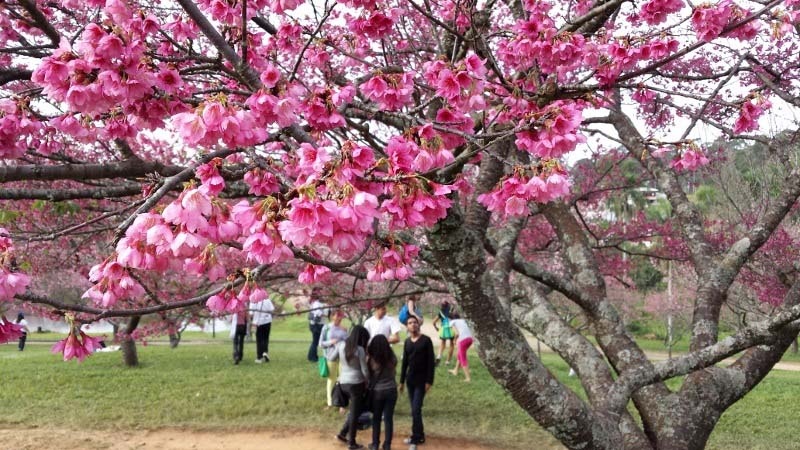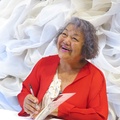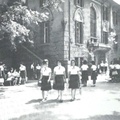If you want to call Brazil your "home," plant a cherry tree.
For prewar immigrants, seeing cherry blossoms was a dream, as they were something only found in Japan.
Seedlings and seeds of commercial crops such as pepper, jute, tea, and many vegetables had been brought to Brazil before the war, but cherry tree seedlings only began to be brought to Brazil after the war. Why was this the case?
Listening to Shimada's story, I was reminded of the time I interviewed the late Nishitani Hiroshi (1919-2015), who was known as "Hanasaki Grandpa."
He was one of the people who started planting cherry trees in Carmo Park in São Paulo, and is also known as the haiku poet Nishitani Nanpu, who published a collection of haiku called "Sakuramori" (2007). In his biography, he writes that he started to get involved in cherry tree planting as part of the commemorative projects for the 70th anniversary of Japanese immigration in 1978.
Since then, as chairman of the Carmo Park Cherry Tree Planting Committee for 25 years, he has planted 1,500 trees, developing the park into a famous cherry blossom spot that the city of São Paulo is proud of. He is truly a man worthy of the title "Grandpa Who Makes Flowers Bloom."
I remember one thing that I heard from Nishitani when I interviewed him at his home in Itaquera in December 2010:
"Once we leave our hometown, we can't go back and live here. It's the fate of immigrants. So we thought, let's make cherry blossoms bloom here and make this a good place to live. At the time, even within the colonia, people looked at us with the impression that we were 'some strange people doing this.'"
It wasn't just a matter of planting trees.
"A high-ranking official at the association told me, 'Cherry blossoms are old, and that to be successful it would be better to plant ipées (Brazil's national flower). But we had the feeling that we wanted to make it possible for people to come and see the cherry blossoms here without having to go back to Japan.' After we held a cherry blossom viewing party, people said they wanted to see the hat dance, and it gradually grew bigger," he said with a sigh.
Nishitani introduced the Kasa Odori dance from his hometown of Tottori to the prefectural association, making it possible for people to feel more like home while still being there.
What I felt from Nishitani's story was the strong determination, "After the war, when they resigned themselves to not being able to return to Japan, they all said, 'Let's make Brazil our home. A home has to have cherry blossoms. So let's plant cherry trees. And let's make this our home. That's why we'll keep planting cherry trees.'"
Nishitani came to Brazil in 1929 when he was just 10 years old. He spent his days traveling around the country taking orders for the Uze Shokai company, moving between Birachi and Renopolis on the Noroeste line, and in 1941 he settled in Oswaldo Cruz, a newly developed area, and started a dried goods store.
The war ended in August 1945, and in August 1946, in Oswaldo Cruz, a win-winner man got into a fight with a crowbar and killed a Brazilian, sparking a major riot that engulfed the entire town. Brazilian mobs lynched Japanese people and attacked Japanese homes all over the place.
"We heard loud voices shouting that there was a riot, so we rushed over and closed our store, so there was no damage to our house. But I heard that one Japanese person was killed and others were injured." Naturally, the Japanese Association in town was divided into winners and losers.
Nishitani called for the winners and losers to merge, saying, "It's sad when I think about their children's marriages. It's about time we got together," and in 1960 the two groups came together, with Nishitani becoming its chairman.
In other words, the commotion over who won and who lost died down at the same time that immigrants made the decision to settle in Brazil.
Even after the battle was over and I decided to settle in Brazil, I couldn't shake the feeling that I wanted to die after seeing the cherry blossoms, or that I wanted to die in a place with cherry blossoms. So I brought back seedlings from Japan and planted them in the settlement and in parks.
Cherry blossom viewing spots popping up all over Brazil

The planting of cherry trees in Carmo Park began in the 70th year of immigration, which is said to be the heyday of the Japanese colony, and it has now grown into one of the most famous cherry blossom viewing spots in Brazil. It is also a popular place for Brazilians to relax.
The opening line of the aforementioned collection is "Planting Japanese cherry blossoms and loosening the soil." The commentary goes, "Many members of the first generation of Japanese Americans were presidents of various cultural associations, and I think they had a special attachment to cherry blossoms. Loosening the Japanese soil brought back memories."
In the beginning, the Japanese Cherry Blossom Association sent me seven or eight varieties, including Sekiyama cherry, Oshima cherry, Higan cherry, and Milky Way cherry.
"They live with big dreams. However, after two or three years, the cherry blossom seedlings stop growing. Cherry blossom seedlings from a snowy country are not suitable for the coffee country. Soon after, Yoshioka-san bought a small seedling of the Yukiwari cherry tree from Campos do Jordão. This cherry tree, which originates from Shikoku, has grown well in the land. Just as people have hometowns, so too do cherry trees. People who have seen it say that the Yukiwari cherry tree from Shikoku is the most similar to Japanese cherry trees in the country right now."
—From "Sakuramori"
The immigrants felt a special sense of nostalgia for the Japanese soil that was attached to the seedlings that came from Japan. This feeling is crystallized in the above poem.
However, because São Paulo has a subtropical climate, Himalayan cherry blossoms were the easiest to take root in. Only varieties that bloom in Okinawa and Taiwan seem to take root here. However, when they first started planting Himalayan cherry blossoms, there were concerns such as "The leaves look like peaches" and "This might not be a cherry blossom."
However, as long as the immigrants could see cherry blossoms in their hearts, even substitutes were fine. Incidentally, in Brazil, which is in the southern hemisphere, cherry blossom viewing season is from July to August.
Perhaps what the prewar immigrants meant by "sakura" was "a symbol of homeland itself." The place where the cherry blossoms bloom is "homeland," so when they decided to settle in Brazil, they planted cherry trees here to make it a substitute for Japan.
People can now enjoy cherry blossom viewing without having to travel all the way to Japan like Shimada Umeko's father did, and can experience a sense of "Japaneseness" close to home and ease their nostalgia.
In the state of São Paulo, other famous cherry blossom festivals include the Carmo Park, the Kokushikan Sports Center in São Roque, the Sakura Home in Campos do Jordão, and Garça. They are also planted in large numbers in the Ramos Colony in Santa Catarina and in Apucarana in Paraná.
And now, for Brazilians who were born and raised in such areas, cherry blossoms are becoming an item that evokes a sense of "hometown." This is surely one of the effects that immigrants have on their new homes.
© 2018 Masayuki Fukasawa








